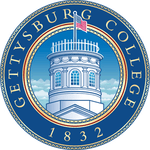Gettysburg College
|
Gettysburg College seal | |
Former name | Pennsylvania College (1832–1921) |
|---|---|
Motto in English | Do Great Work |
| Type | Private liberal arts college |
| Established | 1832 |
Religious affiliation | Evangelical Lutheran Church in America |
Academic affiliation |
NAICU Annapolis Group CLAC |
| President | Janet Morgan Riggs |
Academic staff | 225 |
| Undergraduates | 2,451 |
| Location |
Gettysburg, PA, United States 39°50′14″N 77°14′09″W / 39.837087°N 77.235937°W |
| Campus | Rural, 200 acres |
| Founder | Samuel Simon Schmucker |
| Colors | Orange Blue |
| Sports | Division III |
| Nickname | Bullets |
Sporting affiliations |
NCAA Division III Centennial Conference |
| Website |
www |
 | |
Gettysburg College is a private, four-year liberal arts college founded in 1832, in Gettysburg, Pennsylvania, United States, adjacent to the famous battlefield. The 225-acre (91 ha) campus is located at 300 North Washington Street in the Northwest corner of the town.
Known as the Bullets, the school hosts 24 NCAA Division III men's and women's teams, with a large number of club, intramural, and recreational programs.[1]
Gettysburg College has about 2,700 students, with roughly equal numbers of men and women. Gettysburg students come from 43 states and 35 countries.
In 2012, U.S. News & World Report ranked it 46th among Best Liberal Arts Colleges.[2] In 2015, the Princeton Review ranked Gettysburg College as the 11th in its list of the Best Schools for Internships, only 1 out of 4 liberal arts schools in the top 25.[3] It's also consistently rated as one of the most beautiful campuses in the United States, due to its close proximity to the Gettysburg Battlefield National Park.[4][5]
The college is the home of The Gettysburg Review, a literary magazine.
History
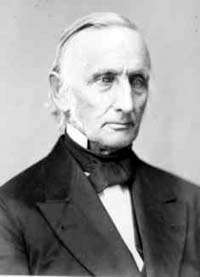
Founding and early roots
Gettysburg College was founded in 1832, as a sister institution for the Lutheran Theological Seminary. Both owe their inception to Thaddeus Stevens, a Radical Republican and abolitionist from Gettysburg. The college's original name was Pennsylvania College; it was founded by Samuel Simon Schmucker. In 1839, seven years after Gettysburg College was first founded, Drs. George McClellan (founder of Jefferson Medical College), Samuel George Morton, and others, founded a medical school, Pennsylvania Medical College, which was located in Philadelphia. The school had money troubles within four years, forcing all founding members to leave their posts.[6][7] After a failed agreement to combine with the Philadelphia College of Medicine in 1858 (closed in 1859, with the faculty begin rolled into Pennsylvania Medical College), the college was forced to close the medical school in 1861. Students from the seceding southern states had withdrawn to return home, leaving it without adequate revenue.[8]
Battle of Gettysburg
In June 1863, southern Pennsylvania was invaded by Confederate forces during the Gettysburg Campaign. Many local militia forces were formed around the area between Chambersburg and Philadelphia to face the oncoming foe.
Among these units was Gettysburg's 26th Pennsylvania Emergency Militia Regiment (PEMR). Composed mostly of students from the College and Seminary, the 26th PEMR was mustered into service on June 22, 1863. Four days later, the students saw combat just north of town, skirmishing with advanced units of Confederate division commander Jubal A. Early. Casualties were light on both sides, but about 100 of the militiamen were captured and paroled.
During the Battle of Gettysburg, Pennsylvania Hall, or Old Dorm, was used as both a signal corps station and field hospital. Due to the geographic position it held, it was used by both Confederate and Union troops during the battle for signal work and surgery.
On November 19, 1863, College President Henry Louis Baugher gave the benediction at the ceremony opening the National Soldiers’ Cemetery at Gettysburg; speaking after Abraham Lincoln. Classes were canceled at the college as students and faculty to hear the now famous Address, establishing the now annual tradition of the "First Year Walk." Henry Baugher was the president of Gettysburg College from 1850 until his death in 1868.
Relationship with the Eisenhowers
Early in his military career, Dwight D. Eisenhower and his wife, Mamie, lived in a house in Gettysburg that was across the street from the college (the Alpha Tau Omega Fraternity House until 1955 on N. Washington Street). Both were fond of the town, so they decided to retire to a working farm adjacent to the battlefield after he left the army. It was there that President Eisenhower recuperated from his 1955 heart attack.
While living in Gettysburg, Eisenhower became involved with Gettysburg College. He served on the Gettysburg College Board of Trustees, and he was given an office, which he used when writing his memoirs. Eisenhower’s old office is now named Eisenhower House and is occupied by Gettysburg College’s office of admissions.[9] Eisenhower’s grandson, David, and his granddaughter Susan continue a certain level of family involvement with the institution.
Today the Eisenhower Institute, a nationally recognized center for leadership and public policy based in Gettysburg and Washington, D.C., is formally recognized as a distinctive program of the college.[10]
Campus
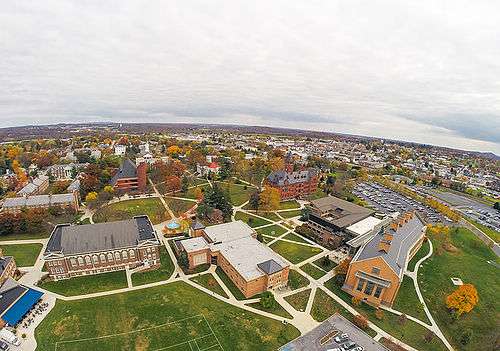
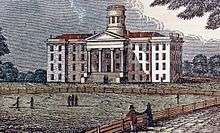
The college is located on a 225-acre (91 ha) campus adjacent to the Gettysburg National Military Park. Gettysburg, Pennsylvania, is 36 miles (60 km) from Harrisburg, 55 miles (89 km) from Baltimore, 80 miles (130 km) from Washington, D.C., 117 miles (188 km) from Philadelphia, and 212 miles (341 km) from New York City, and 425 miles (684 km) from Boston. The college's main campus has over 90 buildings, many of which are historically relevant, and is roughly divided in half by Pennsylvania Hall (administration). The northern half contains Eddie Plank Gym, Masters Hall (physics and astronomy), Musselman Library, the College Union Building, the College Dining Center, Briedenbaugh Hall (English and Asian Studies), and several first-year residence halls and fraternities. A section of this part of campus known as "Stine Lake" is not actually a lake but rather a quad located outside of the library. Prior to Musselman Library being built in the late 1970s, and due to Gettysburg's wet climate and drainage issues, the quad and library site would be prone to accumulating water, creating a large, muddy "lake" of sorts. Today, Stine Lake does not flood, but the name has stuck, to the confusion of first-year students. Additionally, the College Dining Center is known to students and faculty as "Servo," after the now defunct 1980s food service company, Servomation.
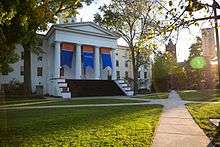
The southern half of the main campus includes McKnight Hall (languages), Glatfelter Hall (computer science, management, political science, mathematics, and others), Schmucker Hall (art and music), Kline Theater, and several fraternities. Over the last half-century, the campus has expanded considerably to include land to the east of North Washington Street and to the west of the traditional campus. Since approximately 96% of students live on campus, most of this additional land is dedicated to housing. It also includes the college chapel, the admissions building, a large gymnasium and field house complex, and several athletics fields. The college has also purchased or leased a large number of buildings for student housing, including residences on Washington Street, Carlisle Street, Middle Street, Stratton Street, and others.[11]
The Majestic Theater
In 1925, Henry Scharf built the Majestic Theater as an expansion to the historic Gettysburg Hotel, located in the center of town. Originally, the building featured a main room that seated 1,200 patrons. In the 1950s, performances in the Theater were attended by President Dwight D. Eisenhower and his wife, often with world leaders or visitors. When he was spending the night in his Gettysburg residence, President Eisenhower used the theater's ballroom as an official White House Press Room for news conferences. The theater was also the location for the world premiere of the civil war epic Gettysburg (1993 film), produced by Ted Turner.[12] In November 2005, the theater underwent a $20 million renovation process, with the main room being restored to its former glory and the addition of two new nightly cinemas. The theater is the location for the college's Sunderman Conservatory of Music performances, as well as musical theater performances and outside guests. Many traditions and orientation events also occur in the building, which seats 816 individuals in a multi-level main room.[13]
Academic facilities
Library
Musselman Library[14] provides access to books, journals, videos, sound recordings, rare books, and manuscripts, many in online format. The online catalog,[15] is freely available and provides a description of the books, DVDs, and CDs in the collection. The journal locator[16] provides a list of online and print journals in the collection. A list of the online databases[17] is available on the library's website. Exhibits are displayed throughout the library and are updated on a regular basis.[18] The library maintains Gettysburg College's institutional repository, The Cupola: Scholarship at Gettysburg College,[19] a collection of scholarly and creative works produced by faculty, students, and other members of the Gettysburg College community.
Special Collections and College Archives,[20] located on the fourth floor of the Library, collects primary sources including rare books, manuscripts, maps, art works, sound recordings, photographs, and other materials which support the curriculum. Special Collections is also home to the College Archives, which preserves records that document college activities, policies, and programs. Rotating exhibits are on display in the Reading Room. Selected items and collections have been digitized and are available via GettDigital.[21]
The building was designed by architect Hugh Newell Jacobsen, who intended the building to complement Glatfelter Hall (1889). Jacobsen referred to the architectural style as "abstract Romanesque".[22] The building project commenced thanks to a large gift from the Emma G. Musselman Foundation.[23] Construction began in 1979 and the building opened on April 22, 1981. Books and other materials were transferred from Schmucker Memorial Library to Musselman Library via a human chain of students, faculty and others.[23][24] In 1986, Jacobsen won both the Award for Excellence in Institutional Masonry Design and the Grand Award for Excellence in Masonry Design for his design of Musselman Library.[25]
Schmucker Hall
Gettysburg College is a well respected institution for the musically inclined. The college is home to the Sunderman Conservatory of Music, which has performed regionally and internationally.[26] Schmucker Hall houses four main classrooms, a 225-seat recital hall, a 10 station technology/piano lab, and 16 practice rooms. Two practice rooms are dedicated organ practice rooms, with a ratio of 6 students for 1 practice room.[27] A recording studio is also found within the building's walls. Choral assemblies usually perform in Christ Chapel, the campus' nondenominational structure that houses a variety of different ceremonies and seats 1,100 individuals.
Glatfelter Hall

Glatfelter Hall is one of the most iconic buildings on campus. Built in 1889 as the New Recitation Building, the deep red brick and gray stone building was redicated in 1912 to honor Philip H. Glatfelter, a trustee and generous benefactor of the college. The building was built in the Romanesque Revival style, with a soaring tower 143 feet high.
Currently, the building features four stories and a basement, with a grandiose main staircase traversing all but the top floor. The building houses the Anthropology, Computer Science, Mathematics, Political Science, Management, and Sociology departments, along with campus management resources. It is completely handicap accessible, with an elevator traversing all floors. The topmost section of the building contains offices, seminar areas, and a small student library, as well as the entrance to the belltower. Atop the tower, Glatfelter Hall's bell can be heard across campus, ringing to mark the hour.
Renovations:
- In 1929 a thorough interior renovation was implemented, providing additional windows in the north and west facades.[28]
- Between 1989-1991 a tower was added for an elevator and stairwell on the south façade and the buildings large attic was refurbished for academic use.[28]
- Between 2013-2014 the interior was renovated consisting of waterproofing the foundation; the addition of a new classroom and seminar room on the ground floor; and mechanical, lighting, sprinklers, and design changed throughout the building.[29]
The Science Center
The Science Center is part of a complex of two buildings. The Science Center itself is the most modern academic building on campus, built in 2002. An 85,000 sq ft. building,[30] the science center was designed to have first-rate scientific equipment, facilities, and resources, and has been continually renovated to include the most up to date material.[31] It includes:
- Greenhouse and herbarium
- 400 MHz NMR spectrometer
- Nd:YAG laser spectrometer
- A scanning electron microscope and transmission electron microscope
- Specialized labs for a dozen different subjects
- Phase contrast and epifluorescence microscopes
- Animal rooms for endotherms and ectotherms
- Media preparation room (with autoclave, radiation room, and a walk-in environmental chamber)
- Multimedia 'smart' classrooms, lecture rooms, and seminar rooms
- Computer labs
- Dozens of other resources[32][33]
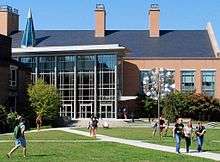
The main building is home to the Chemistry, Environmental Studies, and Health Sciences departments.
McCreary Hall is the other building in the complex, and is older but was renovated during the construction of the Science Center and in 2012.[30] It is home to the Biology and Psychology departments, with the latest equipment including a vast deionized pure water system, infant research lab, space for cognitive neuroscience, and many animal facilities.
Masters Hall
Masters Hall is home to the physics department, and houses several specialized labs, the largest classroom on campus (Mara Auditorium), a machine shop, and a Physics student lounge. In addition, the building also includes an indoor planetarium, Hatter Planetarium which gives students glimpses of what the night sky will look like each month.[34] It also has private shows for classes and performances on different, special topics. Some of the equipment available for student use and regularly used for professor's research includes:
- Modernized telescopes and microscopes
- An advanced laser research lab used for investigating plasma and laser interactions; includes 25-milliwatt He-Ne laser, two 5 watt argon ion lasers, nitrogen dye laser, and other equipment
- Optical isolation table and optical tweezers
- Other technology relevant to specific classes and professors' research [35]
The building houses astronomy classes and uses the campus' observatory, which is located just past the quarry. The observatory is used for undergraduate astronomical research and includes a 16-inch f/11 Ealing Cassegrain reflector, computer controlled.[36] It also houses a classroom and six Meade telescopes. Since its construction in 1996, the observatory has been a huge benefit to astronomy students and has even made several star discoveries in the early 2000s.[37]
Brua Hall
Brua Hall is the home of the college's theater department. Kline Theatre is the building's main attraction, seating 234 people with a thrust stage and an advanced sound and lighting system, including computer lighting memory control.[38] The stage is home to many performances throughout the year, and is very often used by the theater department in addition to the student run theatre club, the Owl and Nightingale Society. Brua Hall also has a 48-seat blackbox, which with flexible playing space is constantly converted to fit the needs of the performance. The blackbox, Stevens Laboratory Theatre, is used for thesis productions from seniors as well as one-act plays written by students.[38] The building has a fully equipped scene shop facility, stuido and classrom space, dressing rooms, an Actors' Lounge and reception area known as Arms Green Room, and other storage and workroom areas.
Large-scale productions are generally performed in the Majestic Theater.
Other buildings
Economics and Africana studies are housed in a former house that was fully renovated in 2013, as well as in rooms in Glatfelter Hall.
Breidenbaugh Hall and Weidensall Hall are two adjacent buildings that house the English, Asian Studies, Civil War Era Studies, Classics, Education, Globalization Studies, History, Interdisciplinary Studies, Philosophy, and Religion departments. Weidensall Hall was originally built as a YMCA building, complete with a swimming pool, but was massively renovated in 1987.[39] Both buildings feature a revived colonial design, with large columns supporting spacious porches.
Technology
Full network capabilities in all campus buildings and each residence hall room. Students have access to more than 1,300 computers and a complex system of workstations and laboratories. Wireless connectivity is available across 97% of the campus (the other 3% being the practice fields) and in all of the residence halls.
The school provides a large network of technological assistance, known as G-Tech, which is student staffed and IT supported. It offers free technical services including help with personal computers, removing adware or viruses, connecting to the college network, building computers, accessing school servers, and general troubleshooting assistance. The college's network infrastructure has been consistently updated over the past decade to keep up with student demand and modernity. In addition, the technology department has deals for students and faculty to receive discounted personal computers and programs.[40]
The campus welcomed Google in July, 2012 to open the 225 acre campus to Google Streetview.[41] Prospective students are able to walk through every inch of campus to see the facilities and fields.
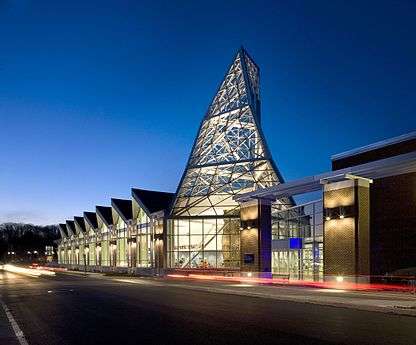
The Center for Athletics, Recreation and Fitness
The college broke ground on the new $25 million athletic center, named the John F. Jaeger Center for Athletics, Recreation and Fitness, on May 30, 2008.[42] The 55,000 foot Center is an upgrade from the former athletic facility, known as the Bream/Wright/Hauser Complex. Bream/Wright/Hauser still exists next to the additions. The Center opened in stages. A dedication ceremony on April 30, 2010 marked its completion.[43] The Center was officially named for the 1965 alumnus John F. Jaeger on May 4, 2012.[44]
The center features:
- A natatorium, complete with eight lanes, four warm-up lanes, and enough space for 350 seated spectators
- A 10,000 foot weight and cardio room complete with flat-screen TVs
- Additional spaces for yoga, aerobics, spinning and martial arts classes
- An upgraded training room with a Hydroworx pool
- Rock climbing walls
- A student lounge and dining space called "The Dive"[45][46]
The Center was created in order to provide more opportunities for the high percentage of students who like to maintain their fitness regimens and engage in intramural, club sports programs, and exercise classes. About 25 percent of the student body participate in varsity sports, while over 75 percent are active in intramural sports. More space was needed, and the Center is important to improve life on campus.[45]
John Jaeger, a 1965 Gettysburg College graduate, donated $1.2 million to encourage others to fund the project. Another important donor, Robert Ortenzio, provided the largest single gift by a living person in the history of the college, by giving $2 million.[45]
Campus safety
Gettysburg College’s Department of Public Safety (DPS) is the primary agency responsible for the enforcement of college policies, security, and emergency response on the campus. The department operates out of 51 W. Stevens St. on the college campus and is open 24 hours a day, 365 days a year. Operated under the supervision of a director (as of 2015, Bill Lafferty), DPS is organized into two divisions, Patrol & Investigative Operations and Life & Fire Safety, each under the management of an Associate Director (as of 2015, Ivan Taylor and David Taylor respectively). The Patrol & Investigative Operations division provides services including any and all emergency response on campus, building security, patrol, community policing, courtesy vehicle jump-starts, crime prevention initiatives, investigations, traffic and parking enforcement, a lost & found program, security escorts, and special event coverage. Patrols are carried out on foot, on a bicycle, or in a vehicle. The department also operates an emergency (717-337-6911) and non-emergency (717-337-6912) telephone line from their office on campus. The Life & Fire Safety division of DPS monitors and maintains all fire systems at the college, as well as the college’s emergency mass notification system (EMNS). DPS has a healthy and working relationship with local law enforcement agencies including the Gettysburg Borough Police Department, Cumberland Township Police Department, and the Gettysburg Barracks for the Pennsylvania State Police. Law enforcement is requested as necessary by DPS and the Gettysburg Police Department often requests the presence of DPS officers on off-campus properties for assistance if there is a tie to the college. Emergency medical services (EMS) are provided by Adams Regional EMS’s MICU 54-1 and Biglerville Fire Department’s MICU 6-1, when needed. The college falls under Gettysburg’s Volunteer Fire Department’s first-due response area. According to DPS’s website, the college employs 20 full-time officers and between 10-15 part-time officers. The structure of the agency includes one major, three lieutenants, one sergeant, and two corporals.
Academics and Student Life
As an independent institution, the college operates under a charter granted in 1832 by the Commonwealth of Pennsylvania. The College is governed by a 39-member board of trustees comprising leaders from a range of professions and walks of life. Thirty of the College’s trustees are graduates of Gettysburg. Gettysburg is considered a more selective college, with admission rates recently hovering around 40%. The Class of 2019 had below a 30% acceptance rate, and Gettysburg often competes with comparable schools Dickinson and Franklin & Marshall for applicants.[47] 82% of the class of 2020 was in the top 25% of their high schools, 64% of students were in the top 10% of their school.[48]
Nearly 2,700 students, approximately one-half men and one-half women and representing 40 states and 39 foreign countries, attend the college. 75% of these students come from outside of Pennsylvania. Around 85% of the student body will graduate in five years,[2] and almost 60% of graduates will study at least one semester abroad. The college has high retention rates, historically hovering around 90%.[2]
On the student level, adjudication of academic disputes takes place through an Honor Commission, which holds hearings in which students are given a chance to have their say on charges brought against them. The Academic Honor Code has been in effect since 1957, and recently has been updated to fit better with today's technology.
The college employs 225 full-time faculty, with 100% of the permanent faculty holding a doctorate or highest earned degree in their fields. The student/faculty ratio is 10:1, with an average class size of 18 students. The college hosts one of only 19 chapters of Phi Beta Kappa in Pennsylvania, as well as 15 other academic honor societies in a variety of disciplines.[49]
Gettysburg is known to be generous with financial aid, with over 70% of students receiving some form of aid.[49] The Princeton Review has called Gettysburg a Best Value College,[50] an award given to schools with exceptional financial aid systems and high rates of employment after graduation. 94% of alumni one year after graduation were either in graduate school or employed. This distinction is given to only 150 colleges in the United States, only 8 of which are in Pennsylvania. The Princeton Review has also called Gettysburg a College That Pays You Back, ranking the college 11th in Best Schools for Internships,[51] one of only four liberal arts colleges to make the top 25.
Academic programs
- Majors
- Anthropology, Art History, Art Studio, Biochemistry and Molecular Biology, Biology, Chemistry, Classical Studies, Computer Science,[52] Economics, English, Environmental Studies, French, German Studies, Globalization Studies, Greek, Health Sciences, History, International Relations and Affairs, Italian Studies, Japanese Studies, Latin, Management, Mathematics, Music, Music Education, Music Performance, Philosophy, Physics, Political Science, Psychology, Public Policy, Religious Studies, Sociology, Spanish, Spanish & Latin American Studies, Theatre, Women Gender & Sexuality Studies
- Special interest programs (minors)
- Africana Studies, Anthropology, Art and Art History, Biology, Business, Chemistry, Civil War Studies, Classics, Computer Science, East Asian Studies, Economics, Education, English, Environmental Studies, Film Studies, French, German Studies, Greek, History, Italian Studies, Japanese Studies, Judaic Studies, Latin, Latin American, Caribbean, and Latino Studies, Mathematics, Middle East and Islamic Studies, Music/Sunderman Conservatory of Music, Neuroscience, Philosophy, Physics, Political Science, Religious Studies, Sociology, Spanish, Theatre Arts, Women, Gender, and Sexuality Studies, Writing
In addition to these majors and minors, the college offers several programs. Students may petition to design their own, individual major. The major must consist of at least 17 courses, including a methods course and a 400-level capstone. Students design a curriculum of their own and choose a faculty advisor. During the senior year, the student takes a 400-level individualized study capstone which is the culmination of their program.[53]
An engineering program is offered as a five-year, Dual Degree program in conjunction with Columbia University in New York City, Rensselaer Polytechnic Institute in Troy, New York, Washington University in St. Louis, Missouri, and the University of Pittsburgh in Pittsburgh, Pennsylvania. Engineering students may choose any of these schools to travel to, taking three courses of liberal arts, mathematics, and physics at Gettysburg College, and two years of advanced engineering and physics classes at their chosen University. Upon completion of the program, students are awarded a Bachelor of Arts degree from Gettysburg College and a Bachelor of Science degree in an engineering discipline from one of the affiliated institutions.
A Nursing program, Optometry program, Pre-Healthy program, Interdisciplinary Studies program, and Pre-Law program are all offered as well, in addition to a Reserve Officers' Training Corps (ROTC) program.
Greek organizations
Fraternities: Alpha Chi Rho, Alpha Tau Omega, Lambda Chi Alpha, Phi Delta Theta, Phi Gamma Delta, Phi Kappa Psi, Sigma Alpha Epsilon, Sigma Chi, Sigma Nu
Sororities: Alpha Delta Pi, Alpha Omicron Pi, Chi Omega, Delta Gamma, Gamma Phi Beta, Sigma Sigma Sigma, Zeta Phi Beta,[54]
Service Fraternity: Alpha Phi Omega
Women's Music Fraternity: Sigma Alpha Iota
Academic Honorary Societies: Alpha Kappa Delta, Delta Phi Alpha, Eta Sigma Phi, Omicron Delta Epsilon, Omicron Delta Kappa, Phi Alpha Theta, Phi Beta Kappa, Phi Sigma Iota, Pi Lambda Sigma, Pi Sigma Alpha, Psi Chi
Past Greek Organizations on Campus: Alpha Xi Delta, Chi Phi, Kappa Delta Rho, Rho Beta (local), Sigma Kappa, Theta Chi, Phi Kappa Rho (local), Phi Mu Alpha Sinfonia, Tau Kappa Epsilon, Zeta Psi, Phi Mu
Students can only rush as sophomores. Around 1/3 of all students are involved in some form of Greek Life, and around 1/2 of eligible students are involved in Greek Life.[1]
Student media
"Gettysburgian" (Campus Print Newspaper), The Forum (www.gburgforum.com, the independent online news source), Channel 34 Gburg TV (Campus Television Station), WZBT 91.1 (Campus Radio Station), The Spectrum (College yearbook).
Every year, the media groups on campus work together to host a journalism and media conference entitled Speak Up, Write Out, bringing in members of the world, national, and local media to speak in panels open to students of Gettysburg and other nearby colleges.
Activities and traditions
The college boasts a wide variety of different events on campus, with an estimated 3,200 cultural events occurring during a four-year period.[1]
Activities
There are more than 120 clubs and organizations on campus, focusing on areas of interest such as community service, art and music, theater and media, academics, student government, career fields, and outdoor adventure. These provide students with over 1,000 leadership opportunities each year, in addition to trips to surrounding metropolitan areas.
Students come from a variety of different spiritual backgrounds, with resources for Jewish, Buddhist, Christian, Muslim, atheist, and Hindu students. An interfaith council is regularly held to promote discuss and communication among the religious groups on campus. The college provides nondenominational worship in the campus chapel and Glatfelter Lodge, and various resources for religious holidays.[55]
Traditions
Gettysburg college has a variety of different traditions during the four year undergraduate experience.
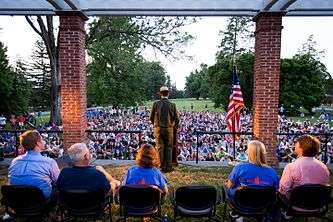
First Year Walk
On November 19, 1863, students marched through town to the National Cemetery to hear President Abraham Lincoln deliver his now famous Gettysburg Address. Since then, first year students have annually marched along the same one-mile path to be welcomed into town and hear the same words spoken over a century ago. Faculty, students, and townspeople cheer the arriving first-years along their walk as the entire town shuts down to participate.[56]
Twilight Walk
Upon completion of the first semester, first-year students walk from the college union building to Pennsylvania Hall along paths illuminated by upperclassmen holding candles. The tradition is designed to welcome first-year students into alumni status, and involves the passing of a Class Book to the college president and the singing of the college's Alma Mater.[56]
Thanksgiving dinner
In a twist of events, every Thanksgiving the dining center opens for a Thanksgiving dinner extravaganza. Students organize themselves and their friends into groups of 8-14 people and receive unlimited turkey, mashed potatoes, stuffing, pumpkin pie, and more, all served by professors and administrators. It is common practice for the president of the college to serve a table as well.[56]
Springfest
Every spring, the weekend before finals the college hosts a well known musician on a constructed main stage in Stine Lake. Other musicians perform in the Attic, the campus' night club. The end of the term is celebrated with concerts, free food, merriment and play. It is common for there to be blow-up obstacle courses, and free beer for students of age.[56]
The Blue Boy
Many students have often reported seeing a frozen child, blue in the face, in one of the upper dorm rooms and its window of Stevens Hall. Dubbed "The Blue Boy," it is said that a young boy was once housed by the women residents of the hall. One cold winter night, the head mother made her evening rounds and forced the girls to hide the boy on the ledge of their window. After a long talk with the girls, the head mother left and the girls went to retrieve the boy, only to find that he was gone. No body had fallen to the ground, but footsteps could be seen walking off into the night. Ever since, residents of that room have experienced strange occurrences, one in which involved the locked window being blown open by the winter wind and a girl spotted the boy on the ledge. After she readjusted her vision, the boy was vanished, but what remained were the words "Help Me" written in reverse on the window itself.[57]
Athletics

Twenty-four sports programs for both men and women participate in NCAA Division III. Gettysburg has earned the distinction of having the best win/loss record in the Centennial Conference for the past 14 years.
The Gettysburg College women's lacrosse team won the Division III National Championship in 2011. Head football coach Barry Streeter is the winningest coach in school history as well as the longest-tenured coach in the Centennial Conference, having helmed the program since 1979. He is currently tied for 24th on the All-Time Division III wins list.
The 1964 football team won the University Division of the Middle Atlantic Conference championship with a 7-2 record for the first and only time in school history. The 1966 football team also played in the MAC University Division and captured the coveted Lambert Cup, emblematic of northeastern collegiate supremacy, again for the first and only time in school history. Both teams have been inducted into the Gettysburg College Hall of Athletic Honor as Teams of Distinction.
Twenty-five percent of Gettysburg's students participate in intercollegiate programs, which include twelve sports for men and twelve sports for women. Although the mascot for Gettysburg College is the Bullet, there is no official Bullet mascot at sporting events.
The college also offers an extensive array of club, intramural, and recreational programs.
"Loyalty Song"
- Fair Gettysburg our Alma Mater, hear us praise thy name,
- We'll ever lend our hearts and hands to help increase thy fame.
- The honor of old Gettysburg calls forth our loyalty.
- So cheer (Rah! Rah!) old G'burg's Bullets on to victory!
However, another rendition exists with a few differences and is the one currently in use:
- Hail Gettysburg our Alma Mater, help us praise thy name.
- We'll ever lend our hearts and hands to help increase thy fame.
- The honor of old Gettysburg calls forth our loyalty,
- So cheer (Rah! Rah!) our G'burg Bullets on to fight for victory!
Notable alumni
Government
- James Glenn Beall, former Maryland US Senator
- Carol Bellamy, former New York City Council President and former executive director, UNICEF
- Nathaniel N. Craley, Jr., former US Congressman from Pennsylvania (1965–1967)
- Fred F. Fielding, former (1981–1986, 2007–2009) Counsel to the President; former deputy to the White House counsel (1970–1972); member of the 9/11 Commission
- Bruce S. Gordon, former head of the NAACP (2005–2007)
- George M. Leader, former Governor of Pennsylvania (1955–1959)
- William N. McNair, former mayor of Pittsburgh, Pennsylvania (1934–1936)
- Ron Paul, M.D., U.S. Congressman from Texas; 1988 Libertarian Party presidential nominee; 2008 and 2012 candidate for the Republican Party presidential nomination
- Jeffrey Piccola, Pennsylvania State Senator, former State Senate Majority Whip (2001–2007)
- John S. Rice, former US Ambassador to the Netherlands (1961–1964) and President pro tempore of the Pennsylvania Senate (1939-1940)
Arts and entertainment
- Jackson C. Frank, folk musician[58]
- Carson Kressley, fashion consultant, Queer Eye for the Straight Guy
- Owen Roizman, five-time Oscar-nominated cinematographer for films such as The Exorcist, The French Connection and Network[59][60]
- Stephanie Sellars, writer, actor, and filmmaker
- Karen Sosnoski, author, radio contributor and filmmaker
- Jerry Spinelli, author, winner of the Newbery Medal for Maniac Magee
Academia
- Rev. David Bittle, first president of Roanoke College, the nation's second oldest Lutheran college after Gettysburg
- Ruth J. Person, Chancellor of the University of Michigan (Flint Campus)
- Janet Morgan Riggs, President of Gettysburg College (2009–present)
- Neal Smatresk, PhD, academic research biologist; President of the University of North Texas, Denton
- Edgar Fahs Smith, scientist; provost of the University of Pennsylvania
Science
- J. Michael Bishop, 1989 Nobel Laureate in Medicine for cancer research
- F. William Sunderman, physician, editor, musician, inventor, Medical Director for the Manhattan Project at Los Alamos, New Mexico
- John Bosley Ziegler, physician who discovered Dianabol and pioneered the use of steroids in sport
Athletics
- Joe Egresitz, '67, the only AP Small College 1st Team All-American in Gettysburg football history; inducted into PA Sports Hall of Fame, Gettysburg Hall of Athletic Honor
- Harry O'Neill, one of two Major League Baseball players to die during World War II
- Eddie Plank, MLB Hall of Fame pitcher for the Philadelphia Athletics; not technically an alumnus since he was not a student, but he pitched for his local college's baseball team
- Ron Warner, class of 1962, two-time All-American (1961, 1962) basketball player
- George Winter, former Major League Baseball player
- John Yovicsin, NFL football player, coach at Gettysburg, and coach at Harvard
Military
- Flora D. Darpino, first female Judge Advocate General of the United States Army
- Herman Haupt, American Civil War general who ran the Union military railroad system
- Keller E. Rockey, Lieutenant General, United States Marine Corps, commander of the Fifth Marine Division during the Battle of Iwo Jima
- Charles A. Willoughby, Chief of Intelligence on General Douglas MacArthur's staff during World War II; member of Military Intelligence Hall of Fame
Other
- David Hartman, first blind person to graduate from medical school in the US
- Michael Bitting, Shakeweight inventor
Civil War History activities
Due to its close relationship to a crucial battle in the American Civil War, Gettysburg College hosts a number of activities and awards:
- Pennsylvania Hall, located in the center of campus, was occupied by both Union and Confederate forces during the Battle of Gettysburg. Today, a Civil War era-style flag (for the year 1863) flies above the building, which was used as a lookout position and a field hospital during the battle.
- Author Mark Nesbitt's Ghosts of Gettysburg: Spirits, Apparitions and Haunted Places of the Battlefield contains several sightings of paranormal activity on the campus, most notably in Pennsylvania Hall. Students and faculty have claimed to see a civil war soldier at night standing guard atop the building. He will often spot onlookers and take aim at them with his rifle. Another occurrence happened when two administrators leaving the third floor for the first via elevator ended up in the building's basement. When the doors opened, they were faced with a horrifying civil war hospital scene with wounded soldiers and doctors running around. When the two returned later with help the space returned to its normal storage facility.[61]
- In 1982, professor and historian Gabor Boritt founded the Civil War Institute, which hosts annual seminars and tours on Civil War themes. Scholarships are granted to high school students and history teachers to attend the week-long summer event.
- Since 1998, the "Gettysburg Semester", a semester-long immersion in Civil War academic study has been offered.
- Gettysburg College students may elect to pursue a unique interdisciplinary minor in Civil War Era Studies. Requirements include a general introduction course about the Civil War and a capstone senior-level seminar. Students must also select four classes of at least two disciplines. Classes offered include military history, Economics of the American South, Civil War Literature, films about the Civil War, and Gender Ideology in the Civil War.
- The Lincoln Prize has been awarded annually since 1991 for the best non-fiction historical work of the year on the Civil War.
- Starting in 2005, the Michael Shaara Prize has been awarded for excellence in Civil War fiction. Shaara was the author of the Pulitzer Prize-winning novel about the Battle of Gettysburg, The Killer Angels.
Gallery
- Climbing wall
- Masters Hall
- Pennsylvania Hall
- Schmucker Hall
- Student mailboxes
- Glatfelter Lodge
- McCreary Hall and the Science Center
- Bookstore
- Musselman Library
- View from Lincoln Street
- Bream-Wright-Hauser Athletic Complex
- Pennsylvania Hall, from Musselman Library
- Science Center
- Dining Center ("Servo")
 Glatfelter hall during the renovation in the Winter of 2014
Glatfelter hall during the renovation in the Winter of 2014 Fall on campus brings many colors.
Fall on campus brings many colors. The Quarry Pond on campus
The Quarry Pond on campus Plank Gym, home to the radio station, yearbook, Anthropology department, and GRAB offices
Plank Gym, home to the radio station, yearbook, Anthropology department, and GRAB offices
References
- 1 2 3 http://www.gettysburg.edu/facts_figures/glance/
- 1 2 3 "Facts & Figures: Student body". Gettysburg College. Gettysburg College. Retrieved 12 May 2014.
- ↑ http://www.gettysburg.edu/facts_figures/
- ↑ http://www.thebestcolleges.org/most-beautiful-campuses/
- ↑ http://www.bestcollegereviews.org/features/most-beautiful-college-campuses/
- ↑ Morton, Samuel George (1849).
 Biographical Notice of the Late George McClellan, M. D.. Philadelphia: College of Physicians of Philadelphia. Wikisource.
Biographical Notice of the Late George McClellan, M. D.. Philadelphia: College of Physicians of Philadelphia. Wikisource. - ↑ Darrach, William (1847).
 Memoir of George McClellan, M.D.. Philadelphia: King & Baird. Wikisource.
Memoir of George McClellan, M.D.. Philadelphia: King & Baird. Wikisource. - ↑ "Extinct Philadelphia Medical Schools". Philadelphia Medical History and the University of Pennsylvania. University of Pennsylvania, University Archives and Records Center. Retrieved April 27, 2015.
- ↑ "Institutional Profile: Gettysburg College". HigherEdJobs. HigherEdJobs.com. Retrieved 12 May 2014.
- ↑ "About the Eisenhower Institute". The Eisenhower Institute at Gettysburg College. The Eisenhower Institute. Retrieved 12 May 2014.
- ↑ "Visiting Gettysburg". Gettysburg College. Gettysburg College. Retrieved 12 May 2014.
- ↑ http://www.gettysburgmajestic.org/behind_the_scenes/
- ↑ http://www.gettysburg.edu/academics/conservatory/students/facilities/majestic/
- ↑ Musselman Library
- ↑ MUSCAT
- ↑ Musselman Library's journal locator
- ↑ List of Musselman Library's online databases
- ↑ http://www.gettysburg.edu/library/news/exhibits/current-exhibits.dot
- ↑ The Cupola: Scholarship at Gettysburg College
- ↑ Special Collections and College Archives
- ↑ GettDigital
- ↑ "The Council of Independent Colleges: Historic Campus Architecture Project". hcap.artstor.org. Retrieved 2015-09-22.
- 1 2 Glatfelter, Charles H. (1987). A Salutary Influence: Gettysburg College, 1832-1985. http://cupola.gettysburg.edu/books/57/: Gettysburg College. p. 849.
- ↑ "Gettysburg College - Happy 25th Birthday Musselman Library". www.gettysburg.edu. Retrieved 2015-09-22.
- ↑ "Jacobsen Architecture-awards". www.hughjacobsen.com. Retrieved 2015-09-22.
- ↑ http://www.gettysburg.edu/academics/conservatory/ensembles/events/asiatour2014/
- ↑ http://www.gettysburg.edu/academics/conservatory/students/facilities/schmucker/
- 1 2 "The Council of Independent Colleges: Historic Campus Architecture Project". 403 Forbidden. Retrieved 2015-07-22.
- ↑ "Glatfelter Hall renovation in full swing; underground construction photos and video". Gettysburg College. 2013-09-03. Retrieved 2015-07-22.
- 1 2 http://www.ba-inc.com/portfolio/gettysburg-college-science-center-mccreary-hall/
- ↑ http://www.pkal.org/facilities/index.cfm?show=project&P_ID=304
- ↑ http://www.gettysburg.edu/academics/chemistry/facilities/
- ↑ http://www.gettysburg.edu/academics/biology/facilities/
- ↑ http://public.gettysburg.edu/~iclarke/hatter/
- ↑ http://www.gettysburg.edu/academics/physics/facilities/
- ↑ http://www.gettysburg.edu/academics/physics/facilities/observatory.dot
- ↑ http://public.gettysburg.edu/~marschal/clea/obshome.html
- 1 2 https://www.gettysburg.edu/academics/theatre/facilities/
- ↑ https://www.youtube.com/watch?v=VK84LlQeAd4
- ↑ http://www.gettysburg.edu/about/offices/it/prospectivestudents/
- ↑ http://www.gettysburg.edu/visiting_gettysburg/virtual_tour/
- ↑ Murphy, Jan. "Gettysburg College will break ground on $25 million athletic facility". Penn Live. Penn Live. Retrieved 12 May 2014.
- ↑ "Gettysburg College to dedicate new athletic center, add name to its Benefactors Wall". News @ Gettysburg. Gettysburg College. 27 April 2010. Retrieved 12 May 2014.
- ↑ Gettysburg College (May 2, 2012). "Center set for Naming Ceremony". Retrieved May 16, 2012.
- 1 2 3 Gettysburg Alumni Page, Gettysburg College's alumni page description of the Center.
- ↑ Gettysburg Sports Page, Gettysburg College's sports page.
- ↑ "Admissions: Class Profile & Statistics". Gettysburg College. Gettysburg College. Retrieved 12 May 2014.
- ↑ "Gettysburg College - Class Profile & Statistics". www.gettysburg.edu. Retrieved 2016-10-05.
- 1 2 "Gettysburg College - At a glance". www.gettysburg.edu. Retrieved 2016-10-05.
- ↑ Gettysburg, 300 North Washington Street; top, Pennsylvania 17325 717 337 6300 Back to. "Gettysburg named a". Gettysburg College. Retrieved 2016-10-05.
- ↑ Gettysburg, 300 North Washington Street; top, Pennsylvania 17325 717 337 6300 Back to. "Gettysburg ranked No. 11 in nation for internship opportunities by The Princeton Review". Gettysburg College. Retrieved 2016-10-05.
- ↑ "Computer Science Department". Gettysburg College Computer Science. Computer Science Department. Retrieved 12 May 2014.
- ↑ http://www.gettysburg.edu/academics/ids/programs/individual-major/
- ↑ http://www.gettysburg.edu/dotAsset/27f73018-a7df-4900-9574-ea3aa5dde19d.pdf
- ↑ http://www.gettysburg.edu/about/offices/college_life/religious-spiritual-life/
- 1 2 3 4 http://www.gettysburg.edu/about/college_history/traditions/all.dot
- ↑ Nesbitt, Mark (2006). Haunted Pennsylvania: Ghosts and Strange Phenomena of the Keystone State. Stackpole Books. ISBN 978-0811732987.
- ↑ Jackson C. Frank
- ↑ Susan King (February 7, 2011). "Cameraman turns his lens on his peers". Los Angeles Times. Retrieved 2012-08-20.
... Owen Roizman has spent his career behind a camera, first as the five-time Oscar-nominated cinematographer of such classics as 1971's "The French Connection,"
- ↑ "Owen and Eric Roizman - Two Biographies". Local 600 International Cinematographers Guild. February 8, 2003. Retrieved 2012-08-20.
Roizman majored in math and physics at Gettysburg College ... The following year, he earned the first of five Oscar nominations for his work on The French Connection. During the subsequent 11 years, Roizman compiled a total of 18 narrative film credits, including Oscar nominations for The Exorcist, Network and Tootsie.
- ↑ Nesbitt, Mark (1991). Ghosts of Gettysburg: Spirits, Apparitions and Haunted Places of the Battlefield. Thomas Publications. ISBN 978-0939631414.
External links
| Wikimedia Commons has media related to Gettysburg College. |
| Wikisource has the text of the 1921 Collier's Encyclopedia article Pennsylvania College. |
- Gettysburg College website
- Official Gettysburg College athletics website
- Papers of Willard S. Paul, president of Gettysburg College (1956–1961), Dwight D. Eisenhower Presidential Library
- Illinois Digital Newspaper Collections: Weekly Gettysburgian (1897-2004)
